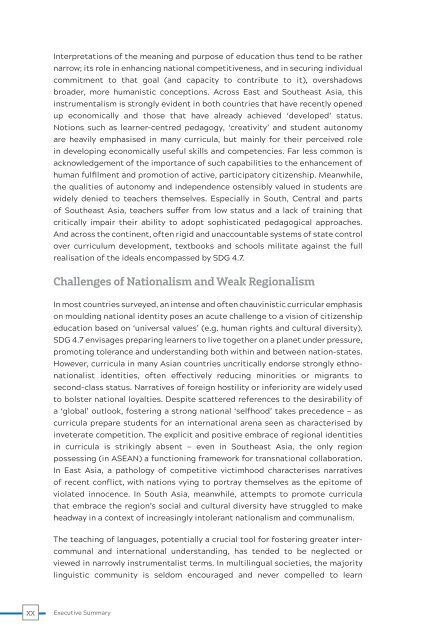Rethinking Schooling for the 21st Century
UNESCO MGIEP officially launched 'Rethinking Schooling for the 21st Century: The State of Education, Peace and Sustainable Development and Global Citizenship' in 2017 at the UNESCO General Conference. This study analyses how far the ideals of SDG 4.7 are embodied in policies and curricula across 22 Asian countries and establishes benchmarks against which future progress can be assessed. It also argues forcefully that we must redefine the purposes of schooling, addressing the fundamental challenges to efforts to promote peace, sustainability and global citizenship through education.
UNESCO MGIEP officially launched 'Rethinking Schooling for the 21st Century: The State of Education, Peace and Sustainable Development and Global Citizenship' in 2017 at the UNESCO General Conference. This study analyses how far the ideals of SDG 4.7 are embodied in policies and curricula across 22 Asian countries and establishes benchmarks against which future progress can be assessed. It also argues forcefully that we must redefine the purposes of schooling, addressing the fundamental challenges to efforts to promote peace, sustainability and global citizenship through education.
Create successful ePaper yourself
Turn your PDF publications into a flip-book with our unique Google optimized e-Paper software.
Interpretations of <strong>the</strong> meaning and purpose of education thus tend to be ra<strong>the</strong>r<br />
narrow; its role in enhancing national competitiveness, and in securing individual<br />
commitment to that goal (and capacity to contribute to it), overshadows<br />
broader, more humanistic conceptions. Across East and Sou<strong>the</strong>ast Asia, this<br />
instrumentalism is strongly evident in both countries that have recently opened<br />
up economically and those that have already achieved ‘developed’ status.<br />
Notions such as learner-centred pedagogy, ‘creativity’ and student autonomy<br />
are heavily emphasised in many curricula, but mainly <strong>for</strong> <strong>the</strong>ir perceived role<br />
in developing economically useful skills and competencies. Far less common is<br />
acknowledgement of <strong>the</strong> importance of such capabilities to <strong>the</strong> enhancement of<br />
human fulfilment and promotion of active, participatory citizenship. Meanwhile,<br />
<strong>the</strong> qualities of autonomy and independence ostensibly valued in students are<br />
widely denied to teachers <strong>the</strong>mselves. Especially in South, Central and parts<br />
of Sou<strong>the</strong>ast Asia, teachers suffer from low status and a lack of training that<br />
critically impair <strong>the</strong>ir ability to adopt sophisticated pedagogical approaches.<br />
And across <strong>the</strong> continent, often rigid and unaccountable systems of state control<br />
over curriculum development, textbooks and schools militate against <strong>the</strong> full<br />
realisation of <strong>the</strong> ideals encompassed by SDG 4.7.<br />
Challenges of Nationalism and Weak Regionalism<br />
In most countries surveyed, an intense and often chauvinistic curricular emphasis<br />
on moulding national identity poses an acute challenge to a vision of citizenship<br />
education based on ‘universal values’ (e.g. human rights and cultural diversity).<br />
SDG 4.7 envisages preparing learners to live toge<strong>the</strong>r on a planet under pressure,<br />
promoting tolerance and understanding both within and between nation-states.<br />
However, curricula in many Asian countries uncritically endorse strongly ethnonationalist<br />
identities, often effectively reducing minorities or migrants to<br />
second-class status. Narratives of <strong>for</strong>eign hostility or inferiority are widely used<br />
to bolster national loyalties. Despite scattered references to <strong>the</strong> desirability of<br />
a ‘global’ outlook, fostering a strong national ‘selfhood’ takes precedence — as<br />
curricula prepare students <strong>for</strong> an international arena seen as characterised by<br />
inveterate competition. The explicit and positive embrace of regional identities<br />
in curricula is strikingly absent — even in Sou<strong>the</strong>ast Asia, <strong>the</strong> only region<br />
possessing (in ASEAN) a functioning framework <strong>for</strong> transnational collaboration.<br />
In East Asia, a pathology of competitive victimhood characterises narratives<br />
of recent conflict, with nations vying to portray <strong>the</strong>mselves as <strong>the</strong> epitome of<br />
violated innocence. In South Asia, meanwhile, attempts to promote curricula<br />
that embrace <strong>the</strong> region’s social and cultural diversity have struggled to make<br />
headway in a context of increasingly intolerant nationalism and communalism.<br />
The teaching of languages, potentially a crucial tool <strong>for</strong> fostering greater intercommunal<br />
and international understanding, has tended to be neglected or<br />
viewed in narrowly instrumentalist terms. In multilingual societies, <strong>the</strong> majority<br />
linguistic community is seldom encouraged and never compelled to learn<br />
xx<br />
Executive Summary

















